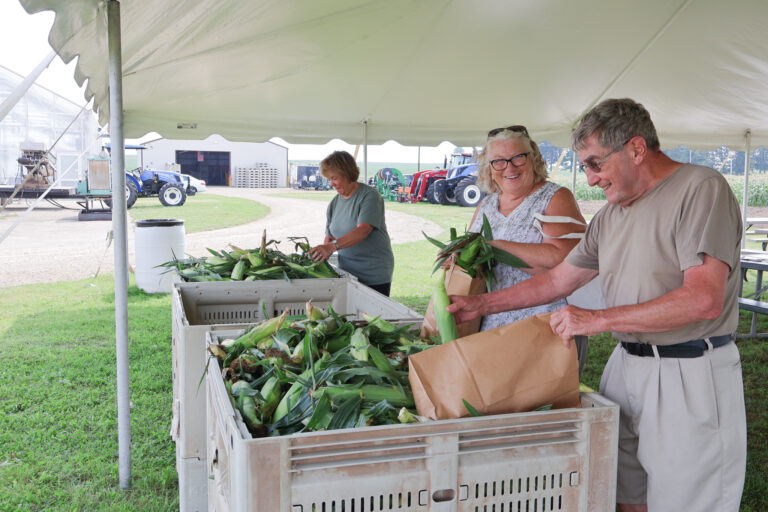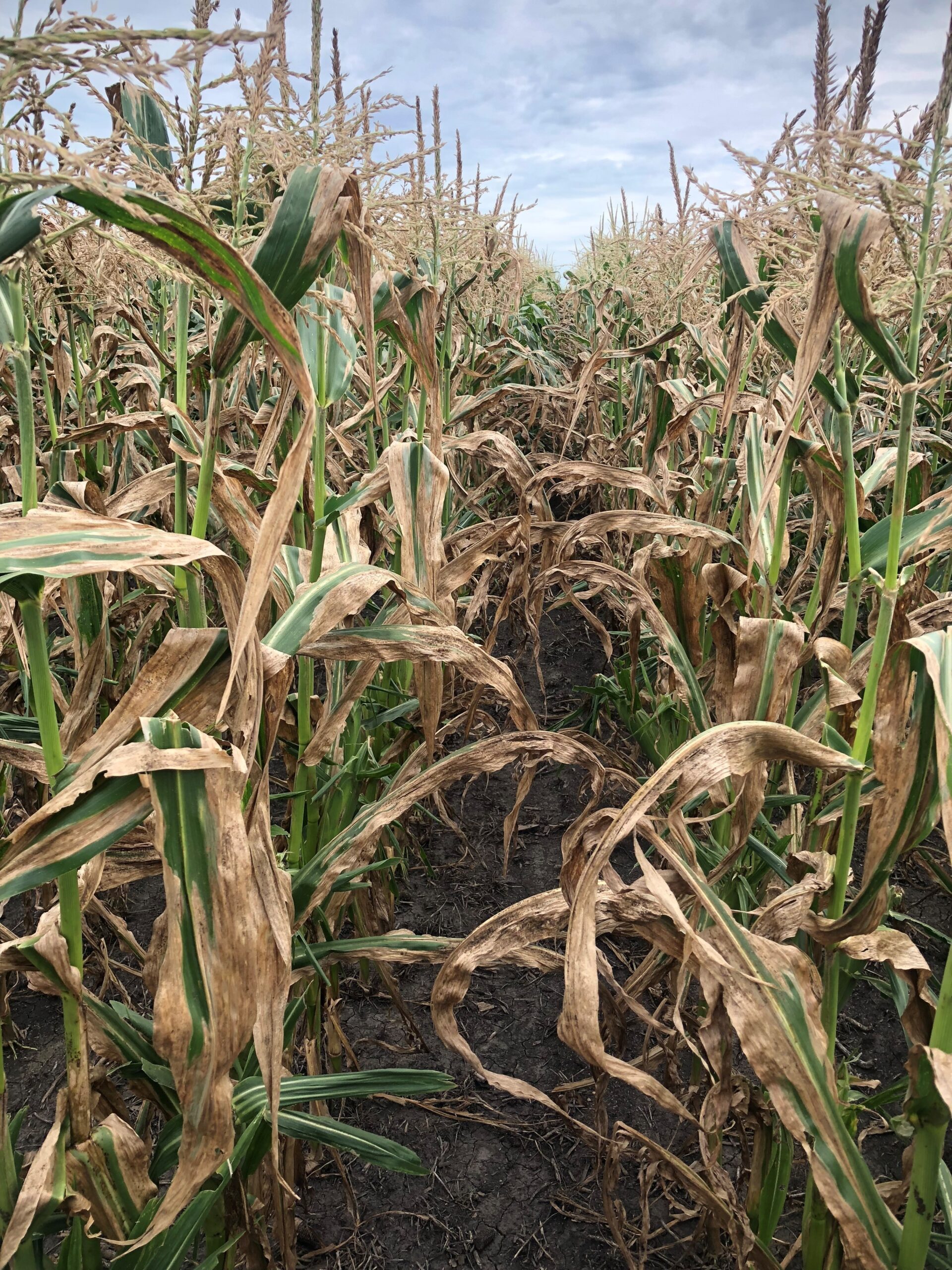
Diseases of Sweet Corn – Northern Corn Leaf Blight (NCLB)
Key Points:
- Northern Corn Leaf Blight is promoted by cool (65-81° F) and humid weather with prolonged dews.
- Disease in the lower canopy (bottom 20-25%) at the time of harvest has limited impact on yield.
- Early-season plantings are typically at low risk.
- IFSI provides hybrid ratings from Resistant (R) to Susceptible (S) to help guide variety selection based on local disease pressure.
- For hybrid ratings and other variety information: https://ifsi.com/products/sweet-corn
- For fungicide efficacy: https://cropprotectionnetwork.org/publications/fungicide-efficacy-for-control-of-corn-diseases
Overview
Northern Corn Leaf Blight (NCLB), caused by the fungal pathogen Setosphaeria turcica (common synonyms Exserohilum turcicum, and Helminthosporium turcicum), can be found in most humid corn growing regions of the world. The arid sweet corn growing regions of California, and the Columbia Basin of Washington for example have little to worry about, but the Midwestern U.S., Northeastern U.S. and the large fresh shipping market of South Florida must contend with this disease nearly annually. The effects of NCLB can be devastating with grain yield losses of up to 50% possible in field corn when disease occurs prior to silking.1 Relationships of disease and yield loss in sweet corn can be complex depending on the market, level of resistance of the variety, age of the plant during infection, and environment, but the impact can be significant.2 We consider NCLB one of the three primary diseases – along with common rust and viruses MDMV/SCMV – that must be managed in temperate sweet corn.
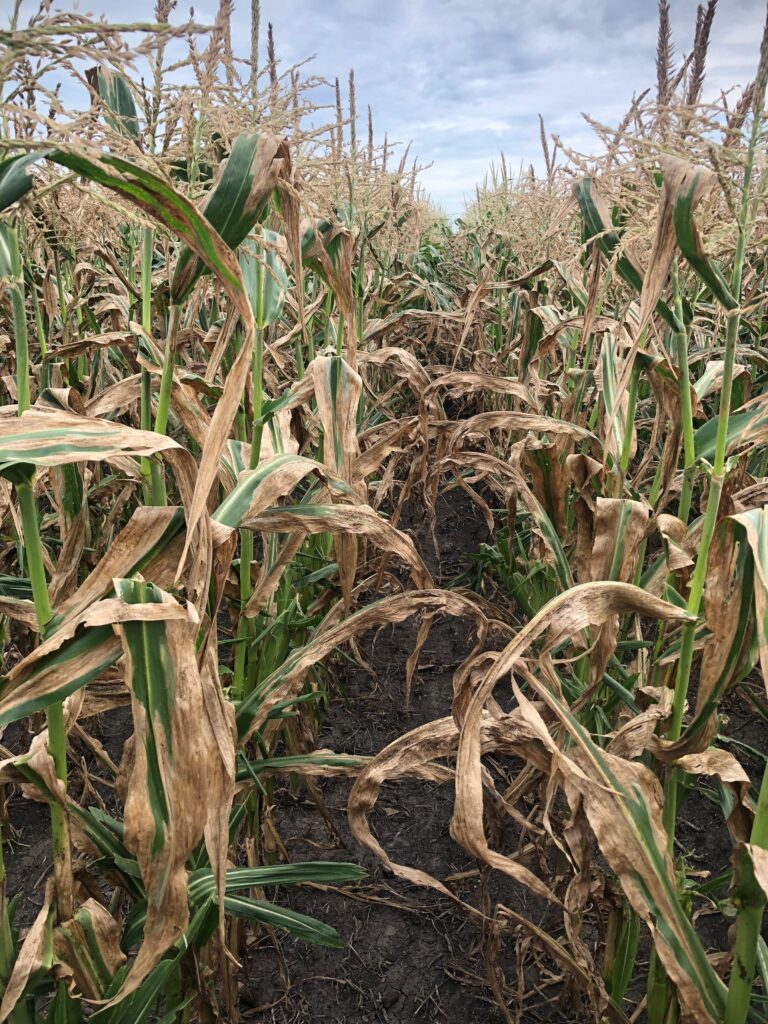
The Pathogen and Symptoms
The pathogen responsible for NCLB overwinters in and on corn debris. The spores produced can be windblown for long distances. Spores initially produced on the overwintering debris infect lower leaves, which if conditions remain favorable, those lesions will produce secondary inoculum that infect upper leaves.
The pathogen favors temperatures between 65 and 81°F, and disease is most severe when there are prolonged periods of heavy dew. Dry years can lead to relatively low disease levels, whereas wet years can increase disease risk and severity. Disease presence in one year can influence the following year by reducing or increasing the amount of primary inoculum. As a result, the year following a wet year may have a greater risk for disease development.
Symptoms of NCLB begin as small greyish, elliptical lesions with a water-soaked appearance.
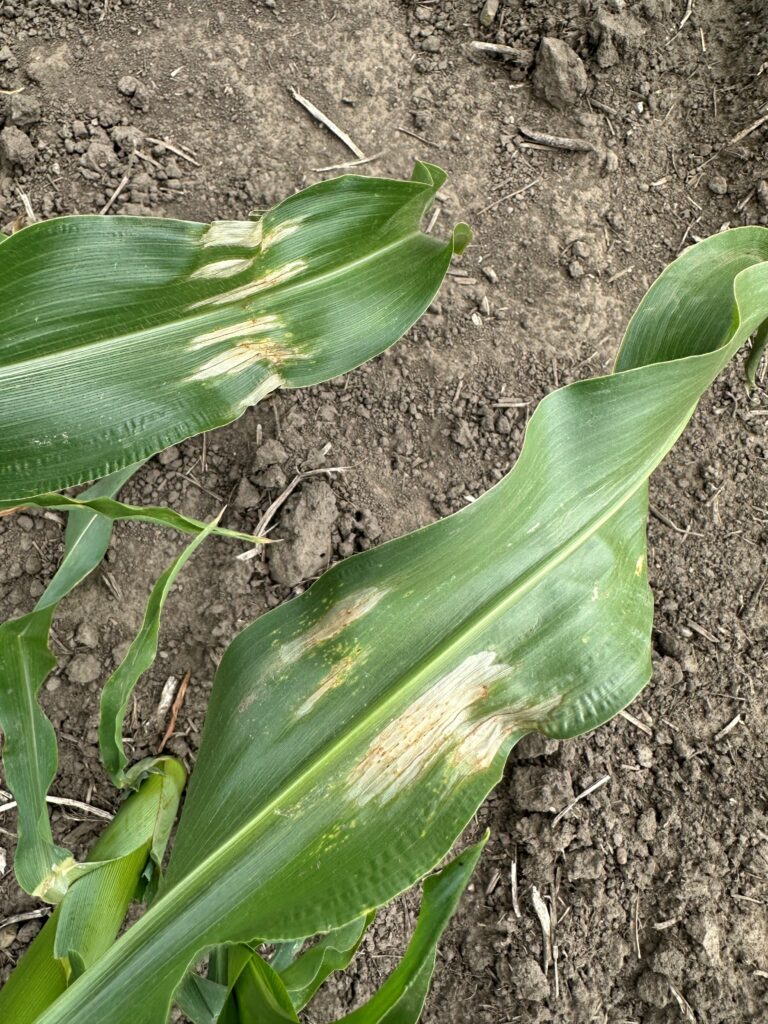
These lesions may continue to elongate into the characteristic large, necrotic cigar-shaped lesions. Depending on a variety’s susceptibility, lesions could reach several inches in length. Certain resistance genes may cause lesions to have a chlorotic halo or streaking on each end.
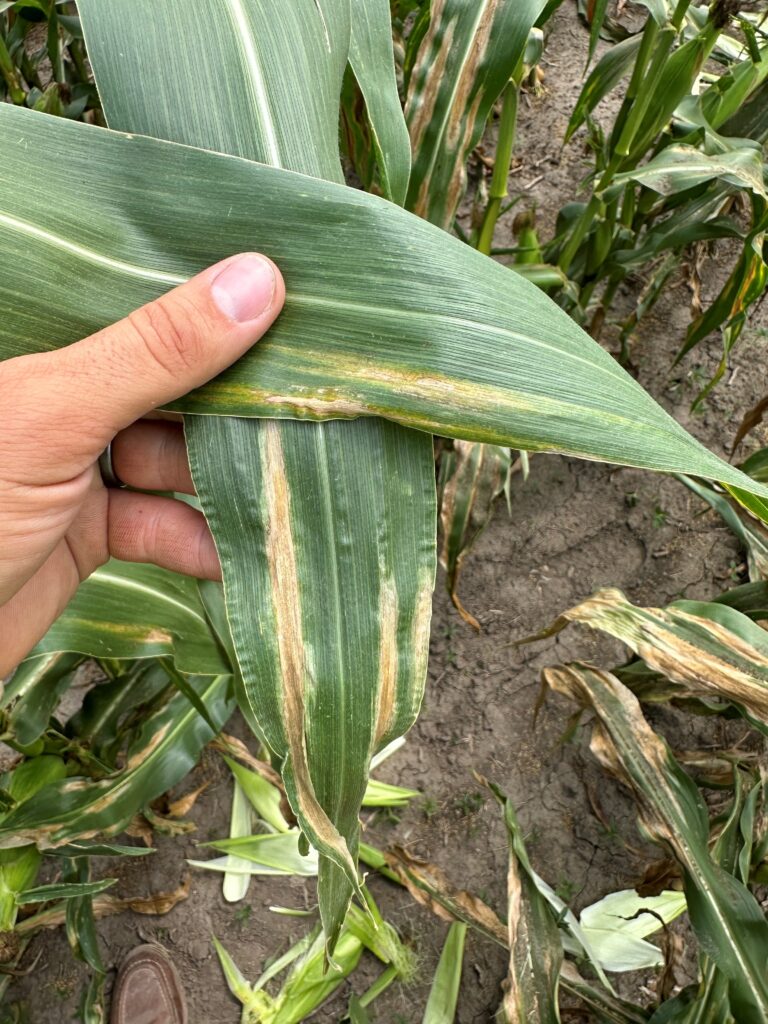
Lesions can coalesce, forming larger blotches of necrotic tissue. With severe disease progression on susceptible varieties, plants may be completely blighted with very little green tissue remaining.
Effects on Sweet Corn
Processing sweet corn, as Carl recently shared, is a yield-driven market, much like grain corn, where yield is measured by pounds of corn produced per acre. For processing markets, such as Minnesota, or Wisconsin, NCLB can reduce ear size, kernel weight, and/or kernel number – all impacting overall yield. However, effects from the disease are minimal if the disease remains confined to the lower leaf canopy. One study reported no yield effect on sweet corn from severe infection in the bottom 25% of the canopy.3 Another study did not measure the disease severity by location within the canopy, but noted yield losses were less than 10% when disease severity was less than 20 or 30% depending on the trial.2 The authors hypothesized in this case the lack of yield impact was likely the effect of most of the symptoms occurring low within the canopy.
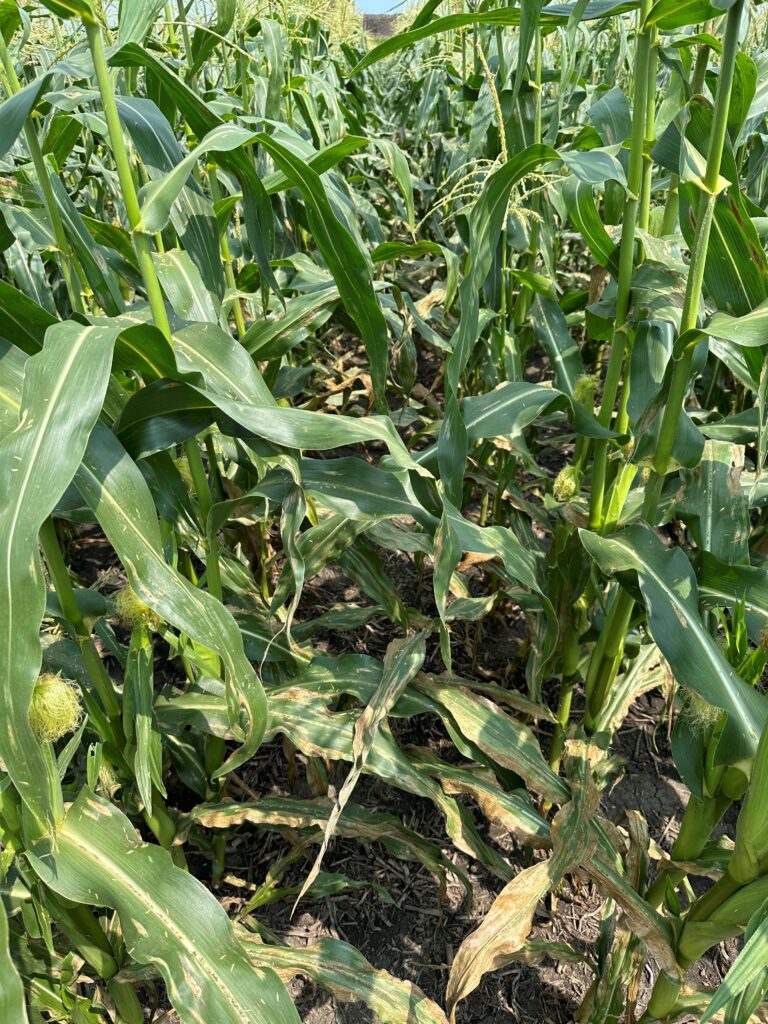
Fresh market sweet corn yield in the U.S. is measured by the number of ears per acre rather than total weight. While NCLB may reduce ear size, ears may remain marketable if tip fill (grain fill) is unaffected. Some varieties tolerate the disease better, limiting fresh market yield impact. Varieties with strong tip fill under stress may show greater disease tolerance.
Early-season plantings of sweet corn can be at lower risk for disease and may escape it all together. This influences variety selection for early planting slots, where resistance is less of a priority. Conversely, later plantings may face higher disease risk, requiring greater emphasis on resistance in later-maturing hybrids.
Successive plantings in sweet corn to ensure stable supply of fresh produce throughout a longer period may put later plantings at greater risk of disease. While disease may occur closer to harvest in one planting, not warranting a fungicide application, that planting can act as inoculum production for the younger corn nearby. Scouting younger corn, those later plantings, and possibly intervening with a fungicide application would be important to reduce impact from the disease.
Management
The pathogen does over winter in crop debris, and thus reducing residue or crop rotation away from corn could lower disease risk. However, spores can travel long distances on wind, and tillage may be an ineffective control alone.
Fungicides are an effective control and are routinely used in high disease environments such as Florida. The decision to apply a fungicide depends on several factors, including region, disease risk, planting time, crop growth stage, and resistance of the variety. As noted, disease in the lower 25% of the canopy close to harvest has minimal impact—thus fungicide would likely not be cost-effective. However, 10% disease severity pre-tassel in a susceptible variety would justify application. The corn disease working group publishes a chart on the efficacy of various fungicides for control of corn diseases. That reference can be found here: https://cropprotectionnetwork.org/publications/fungicide-efficacy-for-control-of-corn-diseases
Host resistance is the most effective means of control. Although, unlike common rust where complete resistance is possible, (i.e. resistance completely prevents symptom development), resistance to NCLB, to the breeder’s dismay, is more complicated. There are single dominant major genes for resistance, referred to as Ht genes after the previous scientific name Helminthosporium turcicum, but the expression of these resistances vary.
Genes designated, Ht1, Ht2, and Ht3 express as chlorotic lesions, while HtN results in a longer latent period (longer period from infection to symptom development).
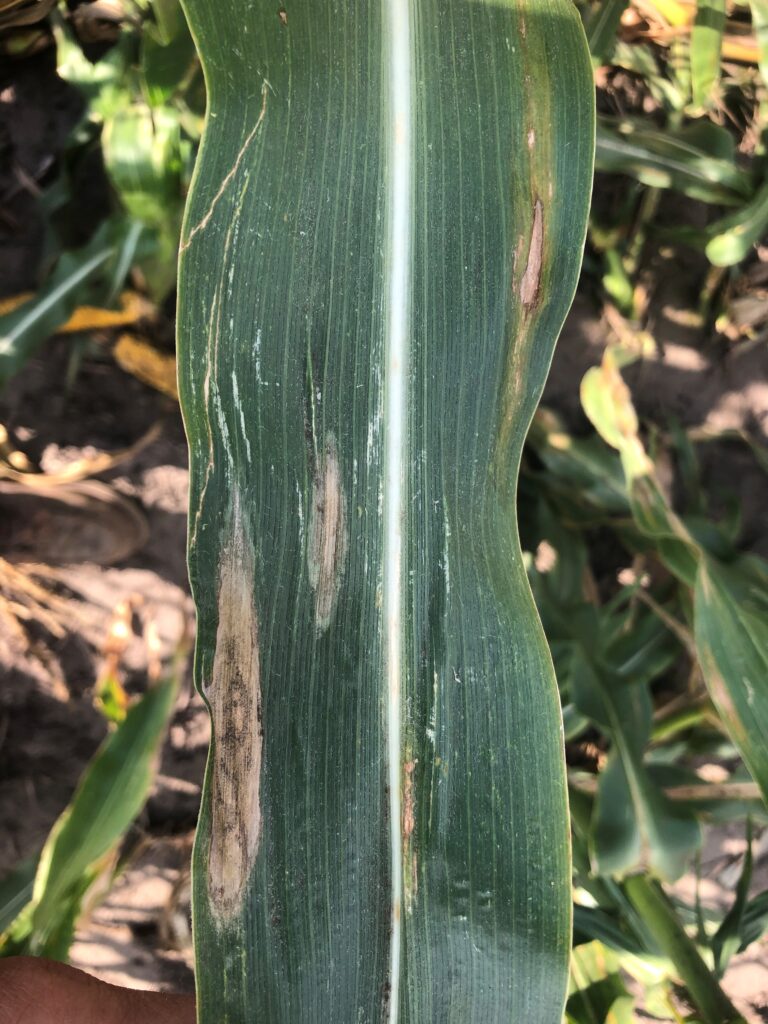
A primary challenge when deploying single gene resistance for NCLB is the widespread prevalence of races of the pathogen that are virulent against these genes, rendering these genes ineffective as control. A study that sampled races across several states in the North Central U.S. found 86.5% of isolates virulent to one or more Ht genes.4 A study conducted in Ontario, reported a similar percentage (76%) of isolates virulent against one or more Ht genes.5 As a result of the widespread presence of races virulent against single gene resistance, a more robust strategy for developing resistant varieties is through the improvement of polygenic or partial resistance. Partial resistance does not rely on single major genes but rather the compounding of many small effect genes which results in resistance that is more durable and stable across environments. Varieties that have partial resistance can have reduced lesion size, lesion number, increased latent period, or a combination of these factors. Ultimately these varieties will have less leaf area infected or delayed onset of the disease when compared to more susceptible varieties. At IFSI we screen thousands of breeding lines and hybrids for NCLB each season. These dedicated disease trials achieve a uniform disease pressure where hybrids are rated on a 1-9 scale based on % leaf area infected. Based on these data, collected over multiple years, hybrids are classified into 5 categories of resistance – Resistant (R), Moderately Resistant (MR), Moderate (M), Moderately Susceptible (MS), and Susceptible (S).
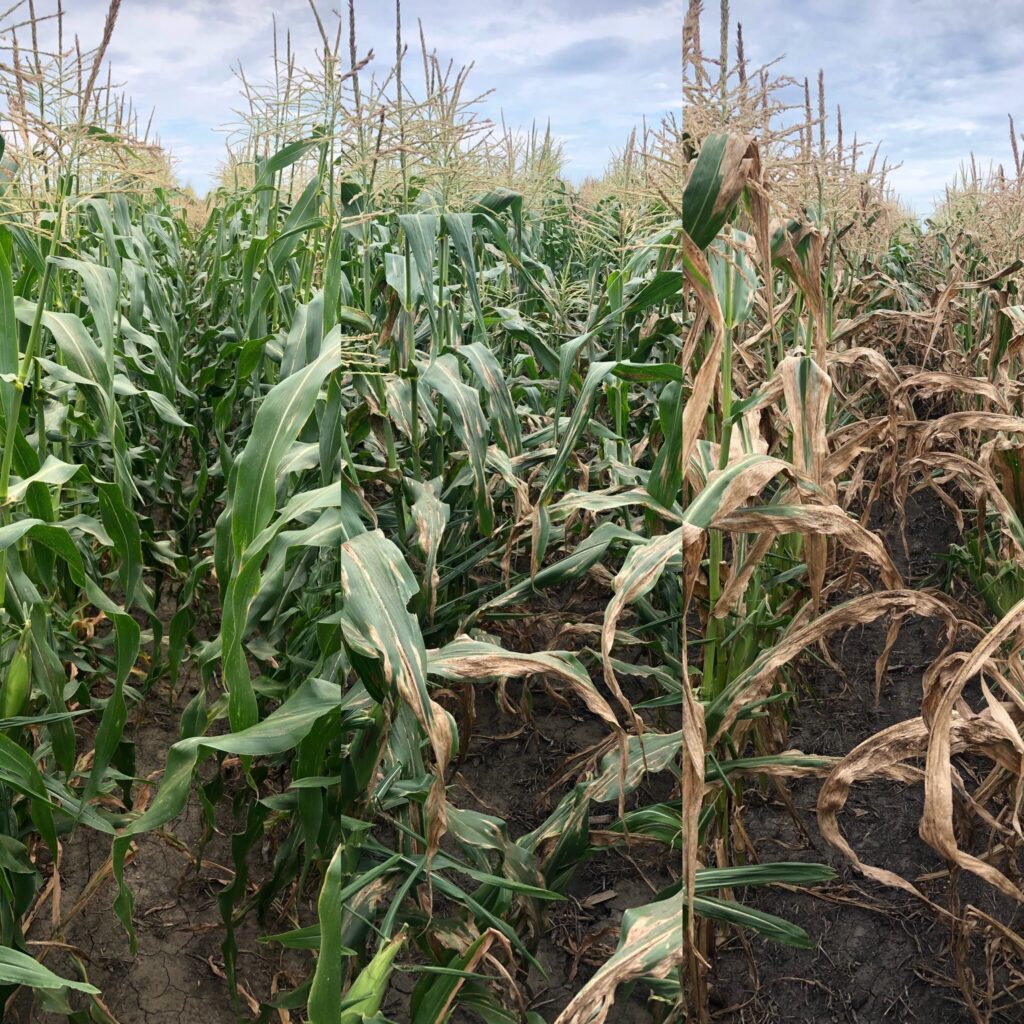
While resistance is on a continuous scale, these categories help guide decisions. Some variation exists within categories – two MR varieties may differ slightly, yet both will perform better than those rated Moderate (M) under disease pressure. When evaluating what level of resistance would be needed for a given environment, it is important to factor in the amount of disease risk for a given location. In low-disease environments, R to M varieties may perform similarly. However, in high-disease settings, MR to S varieties may all succumb, highlighting the need for strong resistance.
IFSI publishes disease reactions for their sweet corn hybrids here: https://ifsi.com/products/sweet-corn/
References:
- Munkvold, G., and D. White. Compendium of corn diseases. No. Ed. 4. AACC International, 2016.
- Pataky, J. K., et al. “Disease severity and yield of sweet corn hybrids with resistance to northern leaf blight.” Plant Disease 82.1 (1998): 57-63.
- Pataky, J. K. “Relationships between yield of sweet corn and northern leaf blight caused by Exserohilum turcicum.” (1992): 370-375.
- Weems, Japheth D., and Carl A. Bradley. “Exserohilum turcicum race population distribution in the north central United States.” Plant disease 102.2 (2018): 292-299.
- Jindal, Krishan K., et al. “Occurrence and distribution of physiological races of Exserohilum turcicum in Ontario, Canada.” Plant disease 103.7 (2019): 1450-1457.


